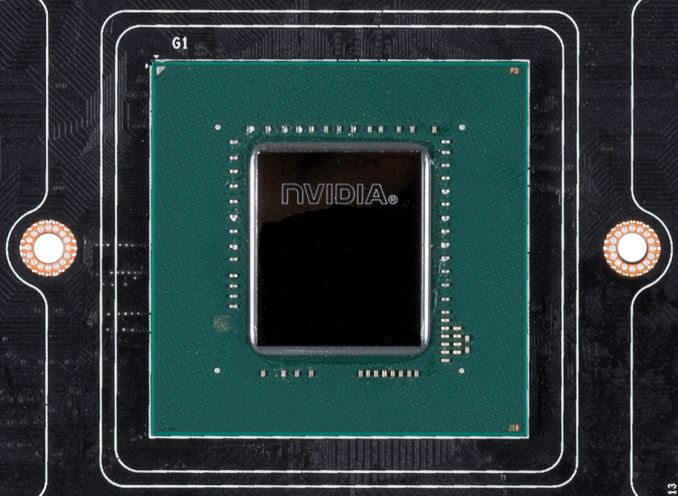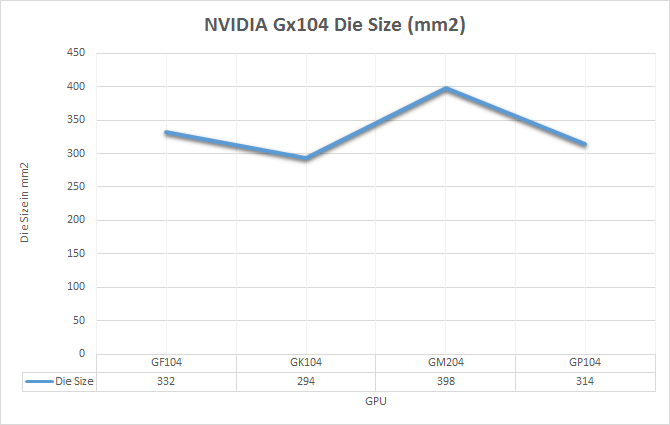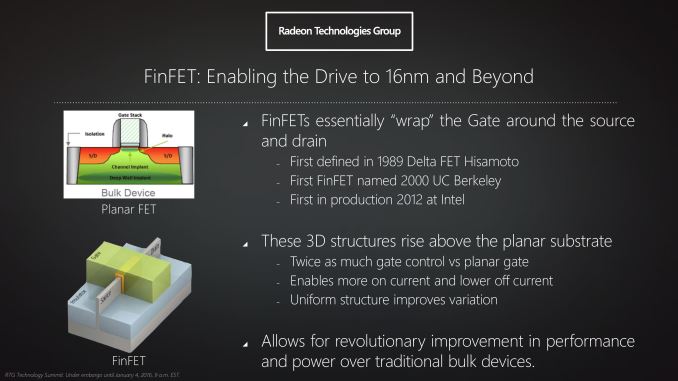The NVIDIA GeForce GTX 1080 & GTX 1070 Founders Editions Review: Kicking Off the FinFET Generation
by Ryan Smith on July 20, 2016 8:45 AM ESTGP104: The Heart of GTX 1080
At the heart of the GTX 1080 is the first of the consumer-focused Pascal GPUs, GP104. Though no two GPU generations are ever quite alike, GP104 follows a number of design cues established with the past couple 104 GPUs. Overall 104 GPUs have struck a balance between size and performance, allowing NVIDIA to get a suitably high yielding GPU out at the start of a generation, and to be followed up with larger GPUs later on as yields improve. With the exception of the GTX 780, 104 GPUs been the backbone of NVIDIA’s GTX 70 and 80 parts, and that is once again the case for the Pascal generation.
In terms of die size, GP104 comes in at 314mm2. This is right in NVIDIA’s traditional sweet spot for these designs, slotting in between the 294mm2 GK104 and the 332mm2 GF104. In terms of total transistors we’re looking at 7.2B transistors, up from 3.5B on GK104 and the 5.2B of the more unusual GM204. The significant increase in density comes from the use of TSMC’s 16nm FinFET process, which compared to 28nm combines a full node shrink, something that has been harder and harder to come by as the years have progressed.
Though the density improvement offered by TSMC’s 16nm process is of great importance to GP104’s overall performance, for once density takes a back seat to the properties of the process itself. I am of course speaking about the FinFET transistors, which are the headlining feature of TSMC’s process.
We’ve covered FinFET technology in depth before, so I won’t completely rehash it here. But in brief, FinFETs are an important development for chip fabrication as processes have gone below 28nm. As traditional, planar transistors have shrunk in feature size – and ultimately, the number of atoms they’re comprised of – electrical leakage has increased. With fewer atoms in a transistor, there are equally fewer atoms to control the flow of electrons.
FinFET in turn is a solution to this problem, essentially allowing fabs to turn back the clock on electrical leakage. By building transistors as three-dimensional objects with height as opposed to two-dimensional objects, giving FinFET transistors their characteristic fins in the process, FinFET technology greatly reduces the amount of energy a transistor leaks. In practice what this means is that FinFET technology not only reduces the total amount of energy wasted from leakage, but it also allows transistors to be operated at a much lower voltage, something we’ll see in depth with our analysis of GTX 1080.
FinFETs, or rather the lack thereof, are a big part of why we never saw GPUs built on TSMC’s 20nm process. It was TSMC’s initial belief that they could contain leakage well enough using traditional High-K Metal Gate (HKMG) technology on 20nm, a bet they ultimately lost. At 20nm, planar transistors were just too leaky to use for many applications, which is why ultimately we only saw SoCs on 20nm (and even then they were suboptimal). FinFETs, as it turns out, are absolutely necessary to get good performance out of transistors built on processes below 28nm.
And while it took TSMC some time to get there, now that they have the capability NVIDIA can reap the benefits. Not only can NVIDIA finally build a relatively massive chip like a GPU on a sub-28nm process, but thanks to the various beneficial properties of FinFETs, it allows them to take their designs in a different direction than what they could do on 28nm.













200 Comments
View All Comments
jcardel - Wednesday, July 27, 2016 - link
This is excactly the same situation as me. I got a 770 sitting in my rig, and am looking hard at the 1070, maybe soon. Although my 770 is still up to the task in most games, I really play only blizzard games theese days and they are not hard on your hardware.My biggest issue is really that it is rather noisy, so I will be looking for a solution with the lowest DB.
Great article, it was totally worth waiting for.. I only read this sort of stuff here so have been waiting till now for any 1080 review.
Thanks!
D. Lister - Thursday, July 21, 2016 - link
Nice job, Ryan. Good comeback. Keep it up.Saeid92 - Thursday, July 21, 2016 - link
What is 99th procentile framerate?Ryan Smith - Thursday, July 21, 2016 - link
If you sorted the framerate from highest to lowest, this would be the framerate of the slowest 1%. It's basically a more accurate/meaningful metric for minimum frame rates.Eris_Floralia - Thursday, July 21, 2016 - link
This is why I love Anandtech. Deep in reviews. Well I even wanted to be one of your editors if you have the plan to create a Chinese transtate version of these reviews.daku123 - Thursday, July 21, 2016 - link
Typo on FP16 Throughput page. In second paragraph, it should be Tegra X1 (not Tesla X1?).Ryan Smith - Thursday, July 21, 2016 - link
Eyup. Thanks!Badelhas - Thursday, July 21, 2016 - link
Great detailed review, as always. But I have to ask once again:why didnt you do some kind of VR Benchmarks? Thats what drives my choises now, to be honest.
Cheers
Ranger1065 - Thursday, July 21, 2016 - link
After over 2 months of reading GTX1080 reviews I felt a distinct lack of excitementas I read Anandtech kicking off their review of the finfet generation. Could it
prove to be anything but an anticlimax?
Sadly and unsurprisingly...NOT.
It was however amusing to see the faithfull positively gushing praises for Anandtech
now that the "greatly anticipated" review is finally out.
Yes folks, 20 or so pages of (well written) information, mostly already covered by other tech sites,
finally published, it's as if a magic wand has been waved, the information has been presented with
that special Anandtech sauce, new insights have been illuminated and all is well in Anandtechland again.
(AT LEAST UNTIL THE NEXT 2 MONTH DELAY.) LOL.
I do like the way Anandtech presents the FPS charts.
Back to sleep now Anandtech :)
mkaibear - Thursday, July 21, 2016 - link
You've hit the nail on the head here Ranger.The info which is included within the article is indeed mostly already covered by other tech sites.
Emphasis on the "mostly" and the plural "sites".
Those of us who have jobs which keep us busy and have an interest in this sort of thing often don't have the time to trawl round many different sites to get reviews and pertinent technical data so we rely upon those sites which we trust to produce in-depth articles, even if they take a bit longer.
As an IT Manager for (most recently) a manufacturing firm and then a school, I don't care about bleeding edge, get the new stuff as soon as it comes out, I care about getting the right stuff, and a two month delay to get a proper review is absolutely fine. If I need quick benchmarks I'll use someone like Hexus or HardOCP but to get a deep dive into the architecture so I can justify purchases to the Art and Media departments, or the programers is essential. You don't get that anywhere else.